dashboard Peugeot Partner Tepee 2016 Owner's Manual
[x] Cancel search | Manufacturer: PEUGEOT, Model Year: 2016, Model line: Partner Tepee, Model: Peugeot Partner Tepee 2016Pages: 296, PDF Size: 10.76 MB
Page 10 of 296
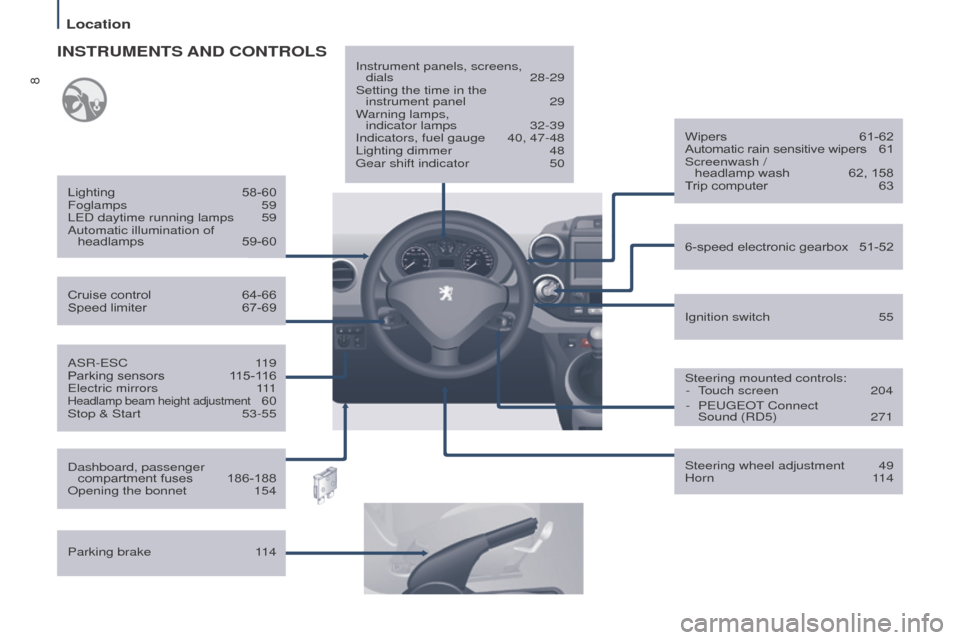
8
Location
ASR-eSC 119
Parking sensors 1 15-116
e
lectric mirrors
1
11
Headlamp beam height adjustment 60
Stop & Start
53-55
Cruise control
64-66
Speed limiter
67-69
Lighting
58-60
Foglamps
59
L
e
D daytime running lamps
59
Automatic illumination of headlamps
59-60
INStRuMeNtS AND
C o N t R o LS
Dashboard, passenger
compartment fuses 186-188o
pening the bonnet
154
Parking brake
1
14Instrument panels, screens,
dials 28-29
Setting the time in the instrument panel
29
W
arning lamps,
indicator lamps
32-39
Indicators, fuel gauge
40, 47-48
Lighting dimmer
48g
ear shift indicator
50
Wipers
61-62
Automatic rain sensitive wipers
6
1
Screenwash / headlamp wash
62, 158
T
rip computer
63
Steering wheel adjustment
49
Horn 114
Ignition switch
55
6-speed electronic gearbox
51-52
Steering mounted controls: -
T
ouch screen
204
-
Peugeo
T
Connect
Sound (RD5)
271
Page 12 of 296
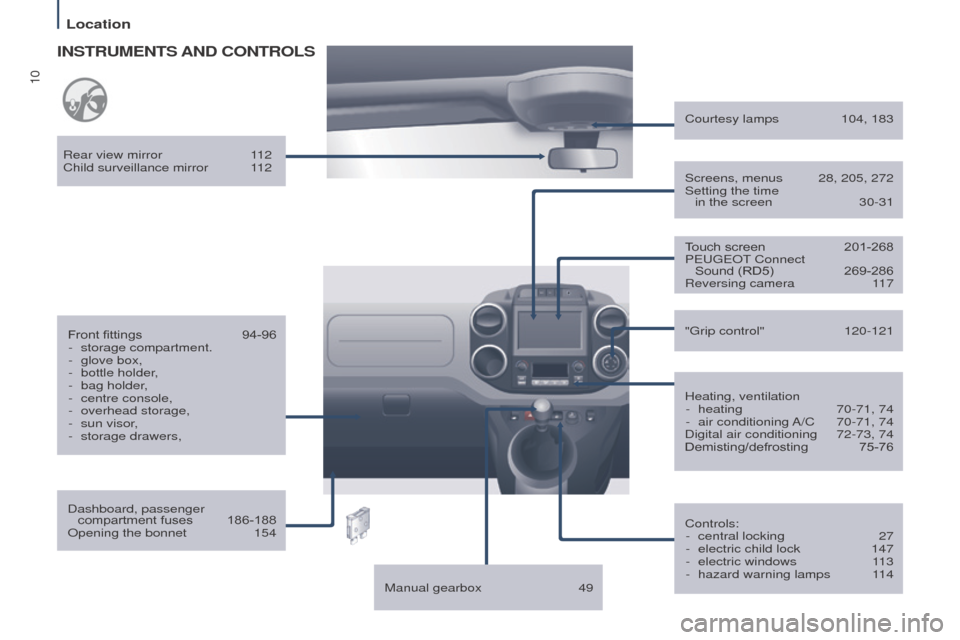
10
Location
INStRuMeNtS AND Co N t R o LS
Dashboard, passenger
compartment fuses 186-188o
pening the bonnet
154
Front fittings
94-96
-
storage compartment.
-
glove box,
-
bottle holder
,
-
bag holder
,
-
centre console,
-
overhead storage,
-
sun visor
,
-
storage drawers,
Rear view mirror
1
12
Child surveillance mirror
1
12
Manual gearbox
49T
ouch screen
201-268
Peugeo
T
Connect
Sound (RD5)
269-286
Reversing camera
1
17
Controls: -
central locking
27
-
electric child lock
147
-
electric windows
1
13
-
hazard warning lamps
1
14
"
g rip control"
120-121
Heating, ventilation -
heating
70-71, 74
-
air conditioning
A/C
70-71, 74
Digital air conditioning
72-73, 74
Demisting/defrosting
75-76
Courtesy lamps
104, 183
Screens, menus
28, 205, 272
Setting the time
in the screen
30-31
Page 29 of 296
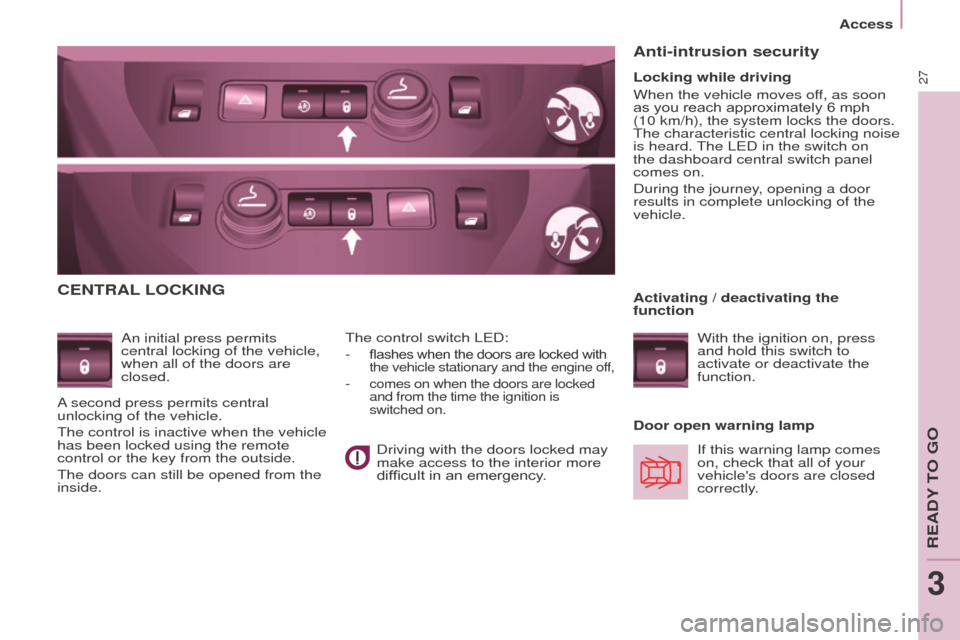
27
Access
CeNtRAL L o CKIN g
An initial press permits
central locking of the vehicle,
when all of the doors are
closed.
Door open warning lamp
The control switch L
e D:
-
flashes when the doors are locked with
the vehicle stationary and the engine off,
- comes on when the doors are locked
and from the time the ignition is
switched on.
Anti-intrusion security
If this warning lamp comes
on, check that all of your
vehicle's doors are closed
correctly.
Locking while driving
When the vehicle moves off, as soon
as you reach approximately 6 mph
(10
km/h), the system locks the doors.
The characteristic central locking noise
is heard. The L e D in the switch on
the dashboard central switch panel
comes
on.
During the journey, opening a door
results in complete unlocking of the
vehicle.
Activating / deactivating the
function
With the ignition on, press
and hold this switch to
activate or deactivate the
function.
Driving with the doors locked may
make access to the interior more
difficult in an emergency.
A second press permits central
unlocking of the vehicle.
The control is inactive when the vehicle
has been locked using the remote
control or the key from the outside.
The doors can still be opened from the
inside.
ReADY To go
3
Page 47 of 296
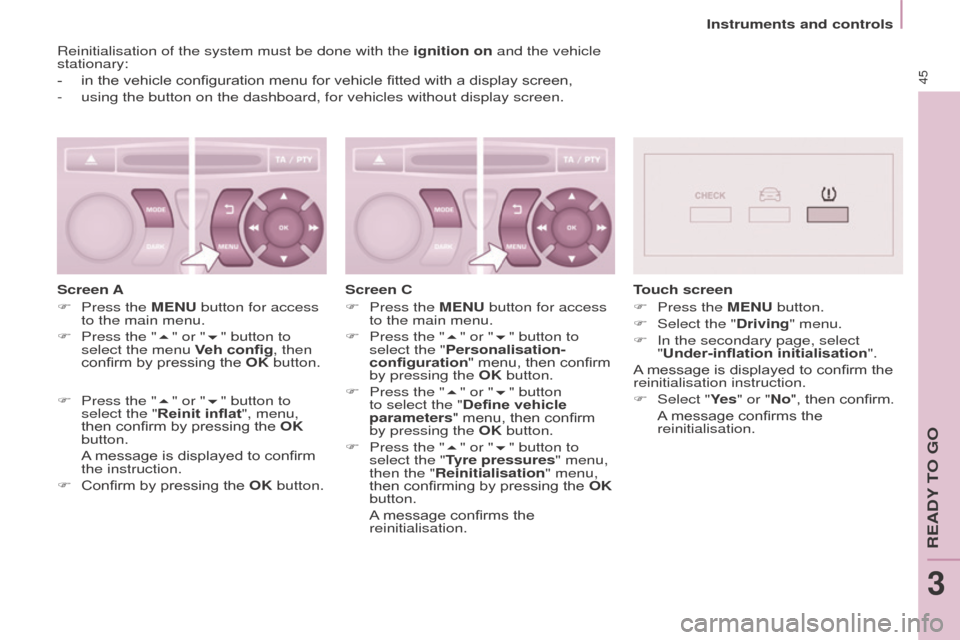
Instruments and controls
45
Reinitialisation of the system must be done with the ignition on and the vehicle
stationary:
-
in the vehicle configuration menu for vehicle fitted with a disp
lay screen,
-
using the button on the dashboard, for vehicles without display screen.
Screen A
F
Press the
M e N u button for access
to the main menu.
F
Press the "
5" or "6" button to
select the menu Veh config, then
confirm by pressing the
o K button.
F
Press the "
5" or "6" button to
select the "Reinit inflat", menu,
then confirm by pressing the
o K
button.
A
message is displayed to confirm
the instruction.
F
Confirm by pressing the
o K button.Screen C
F
Press the
M e N u button for access
to the main menu.
F
Press the "
5" or "6" button to
select the "Personalisation-
configuration" menu, then confirm
by pressing the
o K button.
F
Press the "
5" or "6" button
to select the "Define vehicle
parameters" menu, then confirm
by pressing the
o K button.
F
Press the "
5" or "6" button to
select the "
t
yre pressures
" menu,
then the "Reinitialisation" menu,
then confirming by pressing the
o K
button.
A
message confirms the
reinitialisation.
touch screen
F
Press the
M e N u button.
F
Select the "
Driving" menu.
F
In the secondary page, select
"
Under-inflation initialisation".
A message is displayed to confirm the
reinitialisation instruction.
F
Select "
Ye s" or "No", then confirm.
A
message confirms the
reinitialisation.
ReADY to go
3
Page 48 of 296
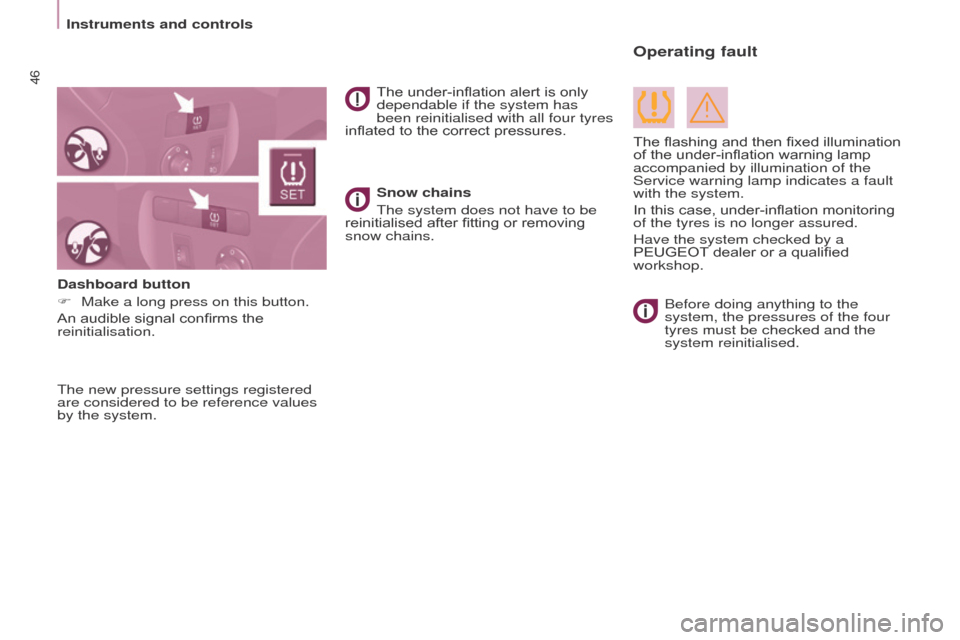
Instruments and controls
46
The new pressure settings registered
are considered to be reference values
by the system.The under-inflation alert is only
dependable if the system has
been reinitialised with all four tyres
inflated to the correct pressures.
Before doing anything to the
system, the pressures of the four
tyres must be checked and the
system reinitialised.
Snow chains
The system does not have to be
reinitialised after fitting or removing
snow chains.
Dashboard button
F
Make a long press on this button.
An audible signal confirms the
reinitialisation.
operating fault
The flashing and then fixed illumination
of the under-inflation warning lamp
accompanied by illumination of the
Service warning lamp indicates a fault
with the system.
In this case, under-inflation monitoring
of the tyres is no longer assured.
Have the system checked by a
PEUGEOT dealer or a qualified
workshop.
Page 74 of 296
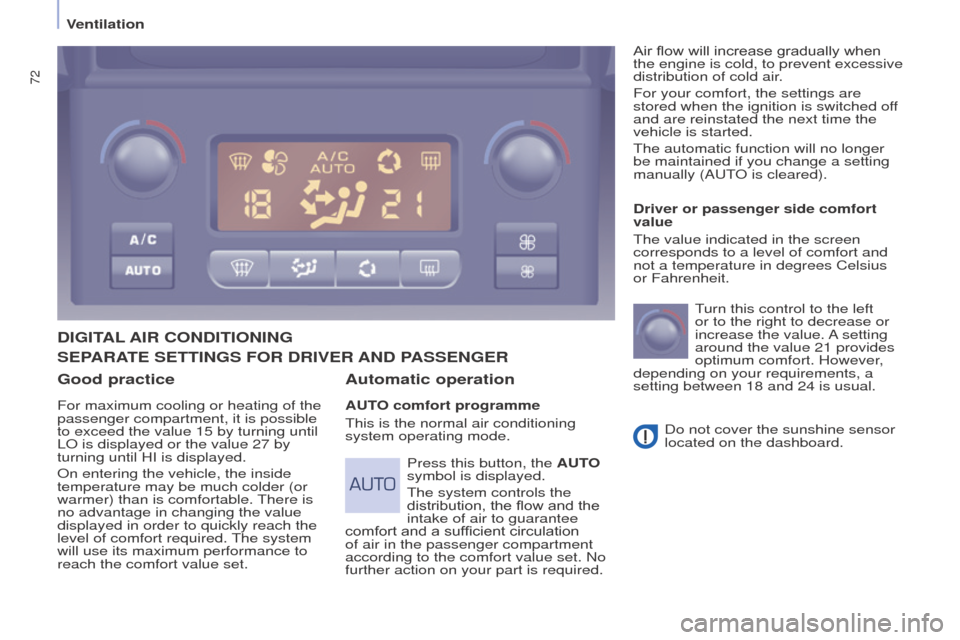
72
good practice
For maximum cooling or heating of the
passenger compartment, it is possible
to exceed the value 15 by turning until
Lo is displayed or the value 27 by
turning until HI is displayed.
o
n entering the vehicle, the inside
temperature may be much colder (or
warmer) than is comfortable. There is
no advantage in changing the value
displayed in order to quickly reach the
level of comfort required. The system
will use its maximum performance to
reach the comfort value set.
DIgItAL AIR C o NDI t I o NIN g
Automatic operation
Auto comfort programme
This is the normal air conditioning
system operating mode. Driver or passenger side comfort
value
The value indicated in the screen
corresponds to a level of comfort and
not a temperature in degrees Celsius
or Fahrenheit.
T urn this control to the left
or to the right to decrease or
increase the value. A setting
around the value 21 provides
optimum comfort. However,
depending on your requirements, a
setting between 18 and 24 is usual.
Do not cover the sunshine sensor
located on the dashboard.
Press this button, the A
uto
symbol is displayed.
The system controls the
distribution, the flow and the
intake of air to guarantee
comfort and a sufficient circulation
of air in the passenger compartment
according to the comfort value set. No
further action on your part is required. Air flow will increase gradually when
the engine is cold, to prevent excessive
distribution of cold air.
For your comfort, the settings are
stored when the ignition is switched off
and are reinstated the next time the
vehicle is started.
The automatic function will no longer
be maintained if you change a setting
manually (A
u T
o
is cleared).
SePARAte
S ett IN g S F o R DRIV e R AND PASS e N ge R
Ventilation
Page 96 of 296
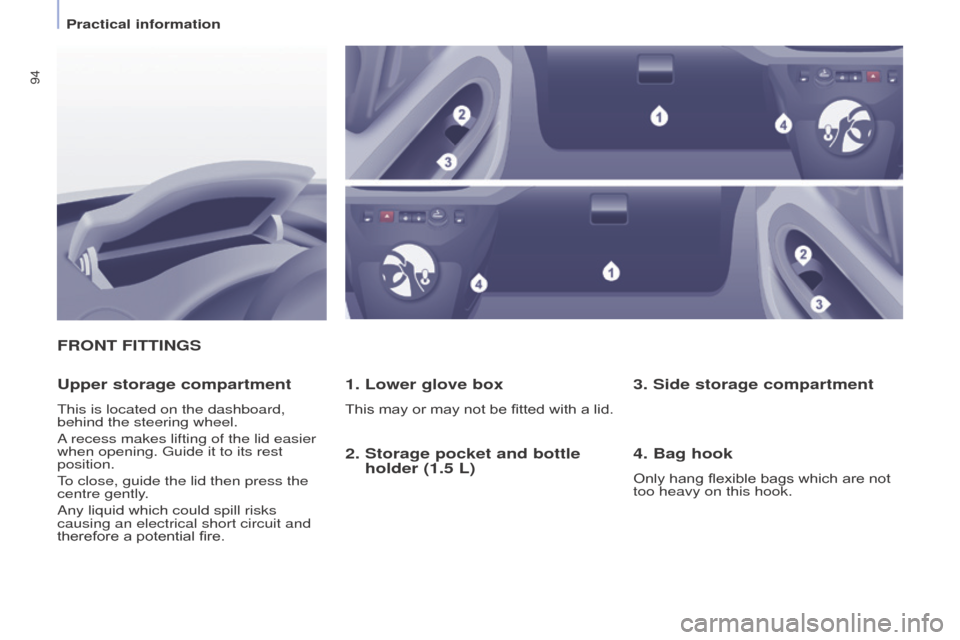
94
FRoNt FIttINgS
1. Lower glove box
This may or may not be fitted with a lid.
upper storage compartment
This is located on the dashboard,
behind the steering wheel.
A recess makes lifting of the lid easier
when opening. g uide it to its rest
position.
To close, guide the lid then press the
centre gently.
Any liquid which could spill risks
causing an electrical short circuit and
therefore a potential fire.
3. Side storage compartment
4. Bag hook
Only hang flexible bags which are not
too heavy on this hook.
2. Storage pocket and bottle
holder (1.5 L)
Practical information
Page 116 of 296
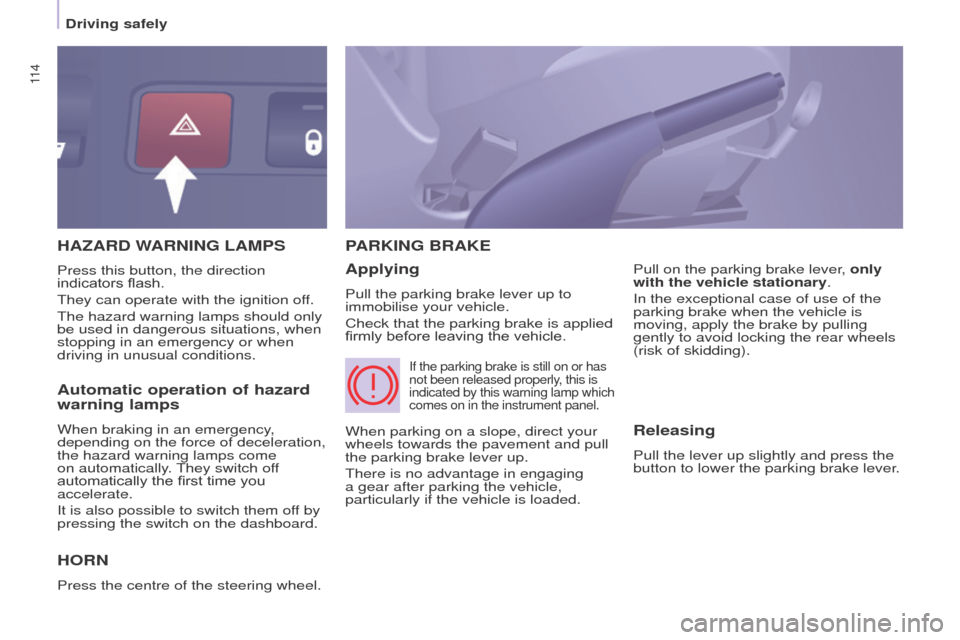
11 4
HAZARD WARNINg LAMPS
Ho
RN
Press the centre of the steering wheel.
PARKIN g BRAK e
Applying
Pull the parking brake lever up to
immobilise your vehicle.
Check that the parking brake is applied
firmly before leaving the vehicle. Pull on the parking brake lever, only
with the vehicle stationary.
In the exceptional case of use of the
parking brake when the vehicle is
moving, apply the brake by pulling
gently to avoid locking the rear wheels
(risk of skidding).
Press this button, the direction
indicators flash.
They can operate with the ignition off.
The hazard warning lamps should only
be used in dangerous situations, when
stopping in an emergency or when
driving in unusual conditions.
When parking on a slope, direct your
wheels towards the pavement and pull
the parking brake lever up.
There is no advantage in engaging
a gear after parking the vehicle,
particularly if the vehicle is loaded.
If the parking brake is still on or has
not been released properly, this is
indicated by this warning lamp which
comes on in the instrument panel.
Automatic operation of hazard
warning lamps
When braking in an emergency,
depending on the force of deceleration,
the hazard warning lamps come
on automatically. They switch off
automatically the first time you
accelerate.
It is also possible to switch them off by
pressing the switch on the dashboard.Releasing
Pull the lever up slightly and press the
button to lower the parking brake lever.
Driving safely
Page 132 of 296
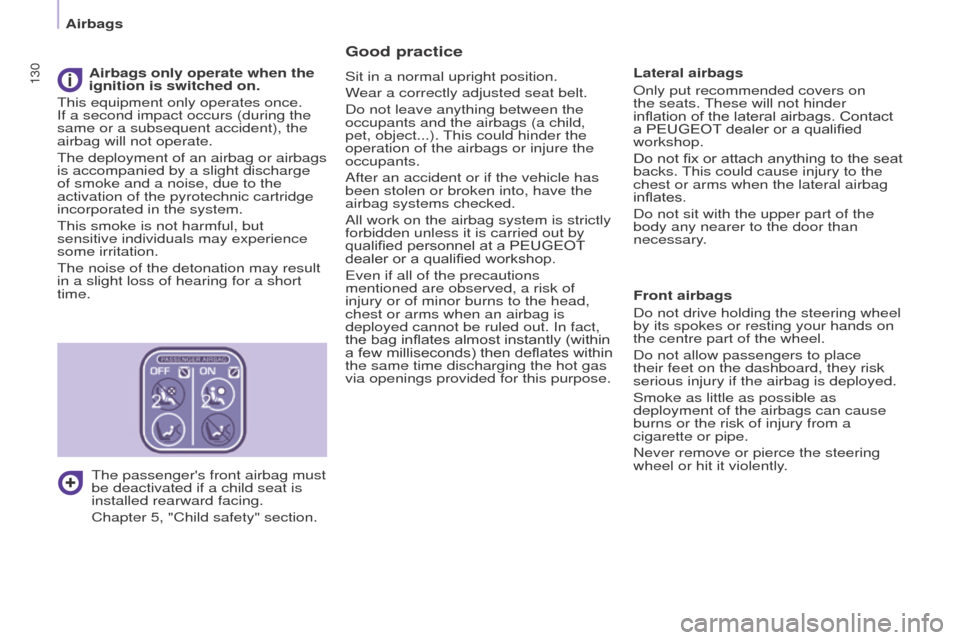
130
good practice
Sit in a normal upright position.
Wear a correctly adjusted seat belt.
Do not leave anything between the
occupants and the airbags (a child,
pet, object...). This could hinder the
operation of the airbags or injure the
occupants.
After an accident or if the vehicle has
been stolen or broken into, have the
airbag systems checked.
All work on the airbag system is strictly
forbidden unless it is carried out by
qualified personnel at a PEUGEOT
dealer or a qualified workshop.
e
ven if all of the precautions
mentioned are observed, a risk of
injury or of minor burns to the head,
chest or arms when an airbag is
deployed cannot be ruled out. In fact,
the bag inflates almost instantly (within
a few milliseconds) then deflates within
the same time discharging the hot gas
via openings provided for this purpose. Lateral airbagso
nly put recommended covers on
the seats. These will not hinder
inflation of the lateral airbags. Contact
a PEUGEOT dealer or a qualified
workshop.
Do not fix or attach anything to the seat
backs. This could cause injury to the
chest or arms when the lateral airbag
inflates.
Do not sit with the upper part of the
body any nearer to the door than
necessary.
Front airbags
Do not drive holding the steering wheel
by its spokes or resting your hands on
the centre part of the wheel.
Do not allow passengers to place
their feet on the dashboard, they risk
serious injury if the airbag is deployed.
Smoke as little as possible as
deployment of the airbags can cause
burns or the risk of injury from a
cigarette or pipe.
Never remove or pierce the steering
wheel or hit it violently.
Airbags only operate when the
ignition is switched on.
This equipment only operates once.
If a second impact occurs (during the
same or a subsequent accident), the
airbag will not operate.
The deployment of an airbag or airbags
is accompanied by a slight discharge
of smoke and a noise, due to the
activation of the pyrotechnic cartridge
incorporated in the system.
This smoke is not harmful, but
sensitive individuals may experience
some irritation.
The noise of the detonation may result
in a slight loss of hearing for a short
time.
The passenger's front airbag must
be deactivated if a child seat is
installed rearward facing.
Chapter 5, "Child safety" section.
Airbags
Page 134 of 296
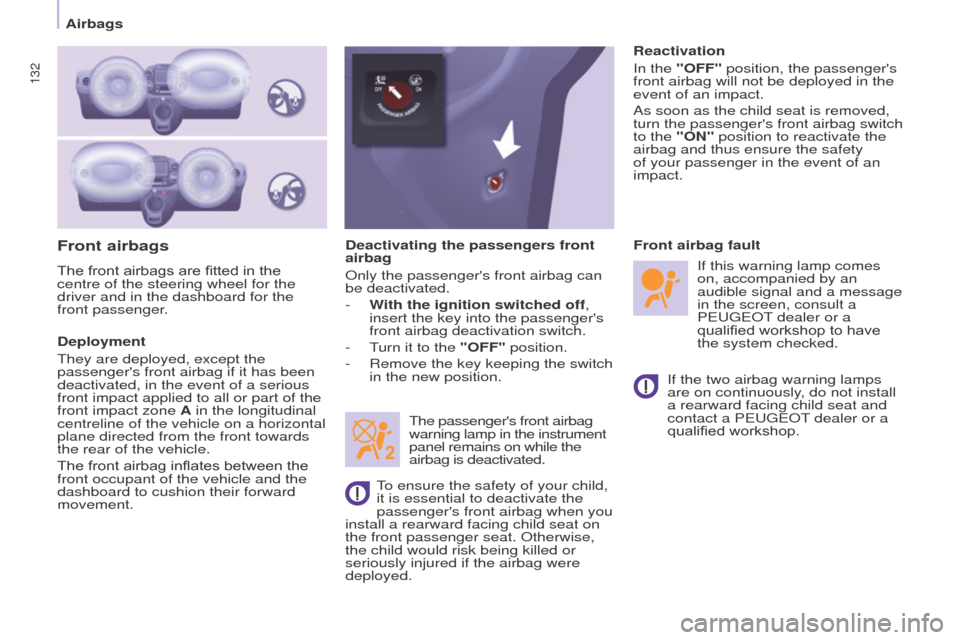
132
Front airbags
Deployment
They are deployed, except the
passenger's front airbag if it has been
deactivated, in the event of a serious
front impact applied to all or part of the
front impact zone A in the longitudinal
centreline of the vehicle on a horizontal
plane directed from the front towards
the rear of the vehicle.
The front airbag inflates between the
front occupant of the vehicle and the
dashboard to cushion their forward
movement.Deactivating the passengers front
airbag
o
nly the passenger's front airbag can
be deactivated.
-
W
ith the ignition switched off,
insert the key into the passenger's
front airbag deactivation switch.
- T urn it to the " o FF" position.
-
Remove the key keeping the switch
in the new position.
The passenger's front airbag
warning lamp in the instrument
panel remains on while the
airbag is deactivated. If the two airbag warning lamps
are on continuously, do not install
a rearward facing child seat and
contact a P
eugeo T dealer or a
qualified workshop.
Front airbag fault
To ensure the safety of your child,
it is essential to deactivate the
passenger's front airbag when you
install a rearward facing child seat on
the front passenger seat.
o therwise,
the child would risk being killed or
seriously injured if the airbag were
deployed. Reactivation
In the "
o FF" position, the passenger's
front airbag will not be deployed in the
event of an impact.
As soon as the child seat is removed,
turn the passenger's front airbag switch
to the " o N" position to reactivate the
airbag and thus ensure the safety
of your passenger in the event of an
impact.
If this warning lamp comes
on, accompanied by an
audible signal and a message
in the screen, consult a
P eugeo T dealer or a
qualified workshop to have
the system checked.
The front airbags are fitted in the
centre of the steering wheel for the
driver and in the dashboard for the
front passenger.
Airbags